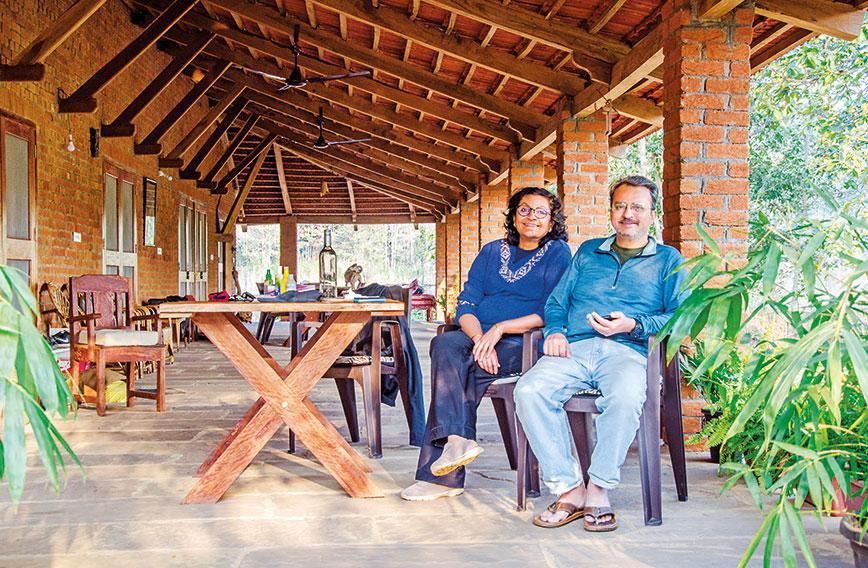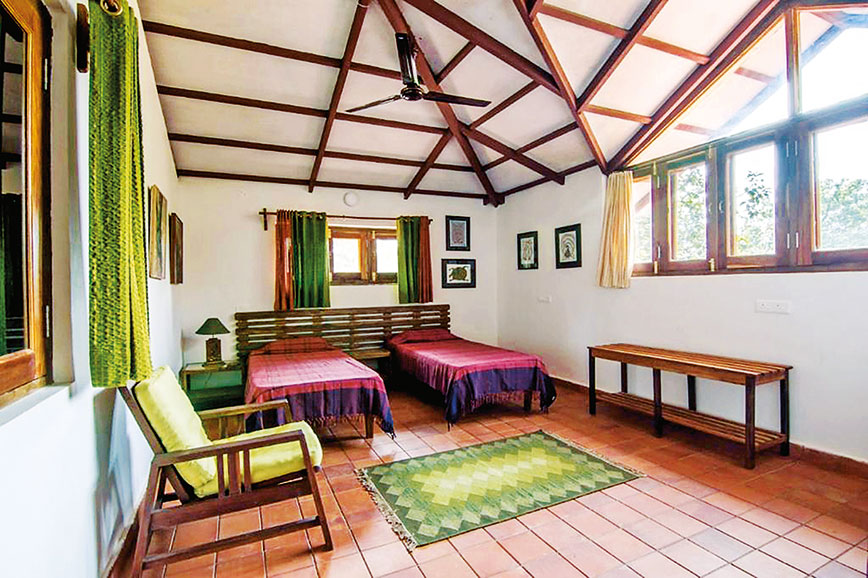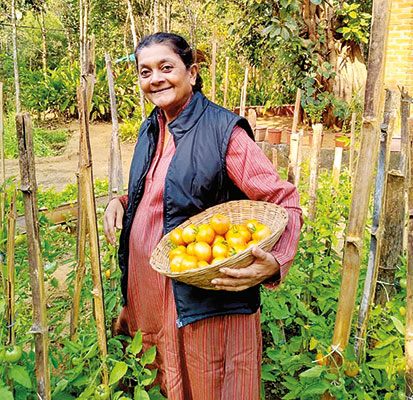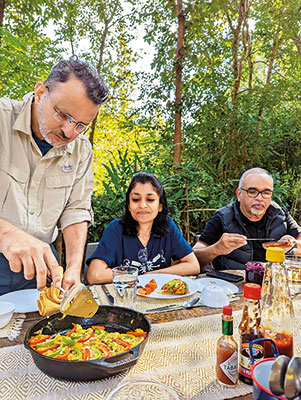
At home in a forest
Civil Society Reviews
WHAT is a good way to go tiger-watching? Slow down, spend time and sink into the forest. Be immersed in its sights, sounds and aromas. Worship the trees. Get acquainted with passing deer. Check out the birds, frogs, snakes and butterflies. Relish those tubers, mushrooms, berries and wild strains of rice. Wind down the evenings with some homemade mahua.
Seeing a tiger is more than a mere photo-op. It is a wondrous experience. Preparing for it is as important as the moment itself. It involves getting the mood right by leaving bustling cities behind and entering a habitat awash with magical attributes.
Salban is a good point of entry. A small homestay on the periphery of the Kanha Tiger Reserve in Madhya Pradesh, Salban has for the past eight years now been quietly raising the bar for wildlife tourism in India.
It consists of a large bungalow, with four rooms available for guests, on 12 acres and is blessed with all things bright and beautiful. There are forays into the forest and tiger sightings that may or may not happen, but what makes Salban special is that it is passionately local. It is quite truly a home in the forest created by Sheema and Aniruddha (Jhampan) Mookerjee after they escaped from the urban jungle of Delhi and Gurugram.
Their house has been built using wood, mud, red brick and stone — all sourced nearby. RCC is at a minimum and cement has been replaced with mud mortar. The wood is from local varieties of trees. Like the materials, carpenters, plumbers, electricians and labour have also been locally sourced from nearby villages.
 |
|
Sighting the reigning queen of Kanha’s |
There is no air-conditioning but the thick mud-mortar walls retain coolness and together with the surrounding greenery keep the rooms cool. The bathrooms are modern in their facilities with top-of-the-line fittings, but natural stone, rather than factory-made tiles, has been used creatively for the flooring. The ambience, touch and feel are natural.
Meals are homecooked and from locally grown crops and vegetables. Local varieties of trees are in abundance such as sal, from which the name Salban comes. There are also fruit trees such as litchi, custard apple, avocado and guava. A mango orchard with 200 trees has pride of place. In the fields rice, wheat and millets are sown from traditional seeds, free of chemical pesticides and fertilizers.
“Our philosophy was simple. Living so close to the core of a tiger reserve, we wanted to be as unintrusive to our surroundings as possible,” says Jhampan about their efforts to create a mini-forest.
 Salban was really meant to be only the Mookerjees’ home. But between 2014 and 2016 the costs of maintaining and greening such a large area began to hit them. In the early part of their careers, they had both been journalists. Over time they had made transitions. When they left Gurugram, Sheema was the publisher of a travel guide company and Jhampan was a wildlife consultant. Now their personal resources and freelance incomes weren’t enough to maintain the expanse of their new home at Kanha.
Salban was really meant to be only the Mookerjees’ home. But between 2014 and 2016 the costs of maintaining and greening such a large area began to hit them. In the early part of their careers, they had both been journalists. Over time they had made transitions. When they left Gurugram, Sheema was the publisher of a travel guide company and Jhampan was a wildlife consultant. Now their personal resources and freelance incomes weren’t enough to maintain the expanse of their new home at Kanha.
It was then that they decided to make Salban into a homestay. The Madhya Pradesh Tourism Board (MPTB) was very supportive though they had just two rooms to rent out. Within a month of applying, Salban was registered as a place where tourists could stay.
“This was a completely new line of work for us, but we seemed to fit in. To begin with, our marketing effort was completely word-of-mouth and guests started trickling in,” says Jhampan. By mid-2017 Salban had been awarded the Best Homestay by MPTB.
Among the pro-active tourism boards in India, Kerala and Madhya Pradesh stand out. Any awards given by these two states are noticed by the media and industry.
The same year Outlook Traveller ranked Salban on top of the 10 best homestays in India.
 Named one of five best places to sleep in, rooms at Salban are high on comfort
Named one of five best places to sleep in, rooms at Salban are high on comfort
“As our online presence improved, we began getting a steady flow of guests who gave Salban five-star reviews,” recalls Jhampan.
“We have maintained a five-star rating on Trip Advisor since 2017, which has given us the Traveller’s Choice Award every year since 2019, the same year Lonely Planet India ranked us among the five best places to eat and sleep in Madhya Pradesh, which was, honestly, a pleasant surprise.”
This year they won the silver for Sustainable Leadership at the Indian Responsible Tourism Awards.
Salban is special because of the easy way in which it melds with its surroundings. Guest houses and hotels in forest reserves tend to be of the cement and concrete variety and an imposition on their beautiful surroundings. There are also the luxury hotels, which seek to replicate every urban comfort. The Mookerjees have a different vision. Their rooms are comfortable but synchronous with the forest. To stay with them is to belong in the forest.
KEEPING IT NATURAL
They started by planting wild species of trees in open areas to create a mixed forest. Over time a mini-forest came up, consisting of 157 different kinds of wild and fruiting trees.
Since they hardly used pesticides and fertilizers, birds, butterflies and moths proliferated. Among the regulars now are spectacular butterflies like the Blue Mormon, Common Map, Orange Oakleaf, Great Eggfly, Sahayadri Commander and Crimson Rose. There are moths like Atlas, Moon, Tussar Silk and various Hawk moths.
 Among rarer birds seen are the Indian Pitta during the rains, Jerdon’s Baza, Indian Scimitar Babbler, Indian Tree Swift, White Rumped Shama and Blue Capped Rock Thrush. From the owl family there are the Brown Hawk (both oriental and Indian), Dusky Eagle and Spot Bellied varieties. There are many regulars like the orioles, treepies and drongos (Racket Tailed, White Bellied and Hair Crested).
Among rarer birds seen are the Indian Pitta during the rains, Jerdon’s Baza, Indian Scimitar Babbler, Indian Tree Swift, White Rumped Shama and Blue Capped Rock Thrush. From the owl family there are the Brown Hawk (both oriental and Indian), Dusky Eagle and Spot Bellied varieties. There are many regulars like the orioles, treepies and drongos (Racket Tailed, White Bellied and Hair Crested).
“Our fence, which allows us to farm, however, discourages herbivores like deer from coming in. But sloth bears and civets are regular during the fruiting season with an occasional tiger during the monsoons. Jackals, foxes and jungle cats can be seen around the property all year round. A special guest in the summer is the Giant Flying Squirrel gliding across our century-old mahua trees,” says Jhampan.
A childhood memory that has never left Jhampan is one of seeing a tiger from his ground-floor bedroom window. The tiger used to walk around his family’s large backyard and sit under a peepul tree.
“We then lived in Jhalawar, a small district town in Rajasthan, and a forest called Darrah, which is part of a tiger reserve today, started from the back of our house. Maybe tigers would once again go past our bedroom, something subconsciously told me,” he says.
By 2018 the Mookerjees began to feel the need for more rooms, but this time they decided to use mud instead of bricks particularly because they could see mud architecture slowly fading out of villages around them.
“With help from our neighbours, we made moulds and started experimenting, making large sun-dried mud bricks ourselves with sand, mud and straw from our land. The bricks took time to stabilize and dry, but the cottage was up in no time,” says Jhampan.
 |
|
Sheema with a fresh harvest of tomatoes: |
It has the same red-tiled roof as the main house. There are two bedrooms with attached bathrooms and pleasant sit-outs facing the sal forest. As with the main house, all the materials were locally sourced. The veranda and bathrooms are laid out with kadappa and kota stone, and the bedroom floors are fitted with terracotta tiles, adding to the natural rustic look.
“Over the years we have become strong proponents of keeping tourism natural and small. We have made sure that our staff remains local and that our surroundings prosper from our small effort. Most of our food is sourced locally and adapts to the rhythm of the seasons,” says Sheema.
“We forage, process and store seasonal wild produce like mushrooms, mahua and fruits. We do, however, watch with some discomfort the growing ills of urbanization around us with large and intrusive tourism properties. Apart from plastic, there is growing noise pollution with throbbing bass-heavy speakers over our landscape that are now a part of every village event,” says Jhampan.
ESCAPING THE URBAN JUNGLE
After having lived 25 years in the National Capital Region (NCR), the Mookerjees were tired of it by 2014. They’d spent the past 12 years in Gurugram in a haze of construction dust, buying tankers of water every third day, suffering jagrans and loudspeakers, parking woes, traffic jams, and endless commutes. The children had grown up and gone their own ways. There wasn’t any reason to stay on in dusty Gurugram.
“We were ready to run but where to we did not know,” recalls Jhampan.
It was the forest of Kanha which beckoned them. In 2005 the Mookerjees had invested in a piece of land at Kanha with some people, hoping to develop it into a sustainable nature lodge on the edge of the tiger reserve. They had paid blind when it was offered to them by a feisty resident of Kanha.
But when they came to register the land, they were stunned by its beauty. Although close to a village, the land shared a boundary with the core of the Kanha National Park with a large patch of thick sal forest and at least 30 mature mahua trees. Deer grazed and tigers and sloth bears visited, they were told. A short walk led to a huge lake where gaur and sambar came to sip water in the evenings.
“We were so mesmerized that we ended up buying 12 acres, much more than what our modest budgets permitted,” confesses Jhampan.
Plans by their feisty friend to build a sustainable tourist lodge never materialized. There were disagreements and others who had invested in the idea slowly backed out. Meanwhile, lodges and resorts sprang up all over the buffer zone of the park. Mercifully, the land the Mookerjees had bought was spared. It was in a place where nothing could have come up. So, their land just sat there with scores of cows grazing on it. The big trees remained untouched but anything they planted got chewed up.
 |
|
Jhampan serves a frittata at breakfast: |
Back home in Gurugram on a particularly depressing evening in March 2014, the Mookerjees took a snap decision — to move to their land in Kanha. The enormity of that decision soon sank in, recalls Sheema. “A four-km fence had to be erected, wells had to be dug, electricity and water lines laid out, and a house to be built from scratch. And all this needed extensive paperwork from multiple authorities, which we surmised would take longer than building the house,” she says.
DESIGNING A HOUSE
The little village of Baherakhar, where the land is situated, remains mostly in a time bubble. Houses are still made of rammed earth, although government schemes are gradually forcing everyone to make ugly concrete boxes. The roofs have irregular red tiles, each home is fronted by a barn for cattle and fodder, and large ficus and mahua trees shade the courtyards.
But the first task which confronted Jhampan and Sheema was to articulate the kind of house they wanted. Some things were very clear to them — the house would have a colonial forest bungalow look and not stick out like a sore thumb. It would be made from local materials as much as possible. How many rooms? They weren’t sure. Should they use mud? They were unsure. One storey or two? They didn’t know. The two had long discussions with Ashok Lall, who specialized in indigenous styles of architecture, and took his advice. Another architect friend suggested two young architects, Meghana Kulkarni and Pooja Chaphalkar, in Pune.
“Our brief for this project was to use minimum RCC, provide large, covered verandas using only locally available material, expertise and labour. The residence was designed keeping in mind the local climate and context, a tight budget and a quirky colonial look. The form of the building was inspired by local houses built in two levels and verandas to provide shade to the main house,” says Kulkarni. Of course, not a single tree was to be cut, there would be no air conditioning and no swimming pool.
The house was built with fired red bricks made in the village, with mud mortar giving it its stand-out red appearance. Everything, from taps, pipes, stone, steel, wood and terracotta tiles for floors and roof, was sourced within a 60-km radius. Workers, masons, welders, electricians, carpenters and plumbers came from Baherakhar or neighbouring villages.
“We found that the local masons were highly skilled at brickwork and with some inputs from us, they were even able to make two large structural arches that we had proposed, even match-casting bricks to the door and window lintels,” says Chaphalkar.
Since local construction and skills were to be deployed, communication with local contractors became very important. “So, we made drawings in Devanagari, models with detachable roofs, sketches and 3D views which made the scheme easy for them to understand,” say the two architects who undertook three exhaustive trips to the site and communicated via phone, emails and videos from the site. “We learnt immensely from this experience, and it has helped us in most of our projects since,” they say.
A WATER DIVINER
The Mookerjees plunged into supervising construction, taking turns to be at the site. A supervisor was appointed to look after labour, purchases and payments. But Jhampan and Sheema worked hands-on to optimize the use of brick and mud, minimize cement and use for doors and windows local timber like sal, beeja and jamun, instead of teak. The house was made earthquake-proof. Expensive synthetic distemper paints were replaced by using just wall putty creatively. Discarded wood was recycled for furniture and fixtures.
 “We even picked up ‘sub-standard’ stones, which were perfectly fine for floors, avoiding expensive tiles. All this made the house look old-world and well lived in, but with a contemporary feel. Visitors are surprised that it is not even a decade old,” remarks Sheema.
“We even picked up ‘sub-standard’ stones, which were perfectly fine for floors, avoiding expensive tiles. All this made the house look old-world and well lived in, but with a contemporary feel. Visitors are surprised that it is not even a decade old,” remarks Sheema.
Perhaps their biggest challenge was getting the right workers and managing them. Men and women were paid differently and when they were offered equal wages, there was some grumbling. In the end, women turned out to be their most consistent workers. But there were funny situations. Workers would vanish for days and, when queried on return, would say: “Our cows were lost, we went to search for them in the forest.” Five days to find a cow? “Yes, sometimes they go deep inside, and we have to look for them. Tigers and leopards can kill them.”
“The cows, we realized, were all bulls. There is no tradition of milk or cows among the Gond and Baiga tribals who live here. The bulls are used for pulling, ploughing and as dung producers for fertilizer. They are considered investments that are bought and sold all the time. In fact, if someone has cows with calves, the entire milk goes to the latter,” says Jhampan.
There was much debate about whether they should have an open well or a borewell. Soil here is sandy and porous with not much clay to retain water. The water table was high, yet it was difficult to find the right vein of water. Their tribal neighbours suggested inviting a water diviner who lived in the next village.
The water diviner, a wizened old man, appeared one morning, looking distracted and uncomfortable. Everyone was very deferential to him. He declined the customary sweet black tea and vanished into the neighbouring forest.
He appeared an hour later with a forked jamun branch. After an elaborate ritual he asked where they wanted him to dig. Out of the 10 locations they suggested, he chose three. And sure enough, the lone one they chose of the three he suggested spouted ample water.
By December 2015 the roof was up with a power connection in place. Bathrooms had running hot and cold water. The Mookerjees moved in to do the interiors. By summer the house was looking lived-in.
They also discovered that they did not need air-conditioning. The surrounding sal forest, thick walls and a high ceiling kept the place cool. “During the hottest of dry summers there would be a 15- to 20-degree variation between day and night with afternoons sometimes going up to 40° Celsius. We have a 30-foot-high ceiling which makes a big difference along with the room coolers,” says Jhampan.
ORGANIC FARMING
With their home built just as they wanted, the Mookerjees turned their attention to growing their own food. The land had not been farmed for years. Crop-raiding by wild boar and deer made growing anything unviable. However, with a fence in place they decided to try.
 |
|
Jhampan performing a ritual puja before sowing |
All around villagers grew paddy and wheat with hybrid seeds and copious amounts of chemical fertilizers and pesticides. It made the rice and roti tasteless. The Mookerjees looked around for local paddy and wheat seeds.
They drew a blank till they discovered Raju and his seed bank off the little town of Paraswada about 50 km away. Not only was he knowledgeable about seeds, but he had also diligently collected over 1,000 local varieties of rice that were no longer in circulation.
With his advice they planted rice varieties like Sathiya, Kali Mooch, Bhalu Dubraj and Jeera Shankar, and Sujata wheat. They also discovered nutritious local varieties of wild millets like kodo and kutki which slowly became their staples. But they realized small-scale organic farming was expensive since yields were not high. With a system of composting pits and beds in place, they produced their own manure and reduced their fertilizer costs.
As grazing was kept at bay with a fence, grasses began to grow again along with woodland species. Invasive plants were removed, and wild species of trees were planted. It is now a mini-forest that attracts birds, butterflies and moths, some rare and some spectacular. “No tigers under our bedroom window yet, but I have not lost hope,” says Jhampan.
Comments
-

Gaurav Khosla - Dec. 12, 2022, 8:02 a.m.
This is the place to go to again, and people to spend time with, again. Definitely not for those who want a loud, action filled stay. Sheema and Jhampan are wonderful hosts who made my stay extra special.
-

Marion White - Dec. 2, 2022, 2:03 a.m.
Having just returned home from a wonderful holiday in India I have to say our last four days spent at Salban Was just the icing on the cake. What a truly fabulous place that Jhampan and Sheena have created a real little bit of paradise in the forest. You really are made to feel like one of the family with the most wonderful home-cooked food, and very comfortable bedrooms . Jhampan and Sheema should be so proud of what they have created and their knowledge on just about anything you can think of is amazing. I will remember sitting round the log fire in the evenings,and their wonderful home cooked meals chatting for many years I came away feeling I’d made some good friends with themselves and their dog scamp .!
-

Prabhat Pani - Nov. 30, 2022, 12:12 p.m.
Beautiful account of a committed couple, who have truly made sustainability their mantra! Sheema and Jhampan: Thank you for your inspirational work - I would love to be in Salban soon!
-

Marion White - Nov. 30, 2022, 12:07 p.m.
Having just returned home from a wonderful holiday in India I have to say our last four days spent at Salban Was just the icing on the cake. What a truly fabulous place that Jhampan and Sheena have created a real little bit of paradise in the forest. You really are made to feel like one of the family with the most wonderful home-cooked food, and very comfortable bedrooms . Jhampan and Sheema should be so proud of what they have created and their knowledge on just about anything you can think of is amazing. I will remember sitting round the log fire in the evenings,and their wonderful home cooked meals chatting for many years I came away feeling I’d made some good friends with themselves and their dog scamp .!



